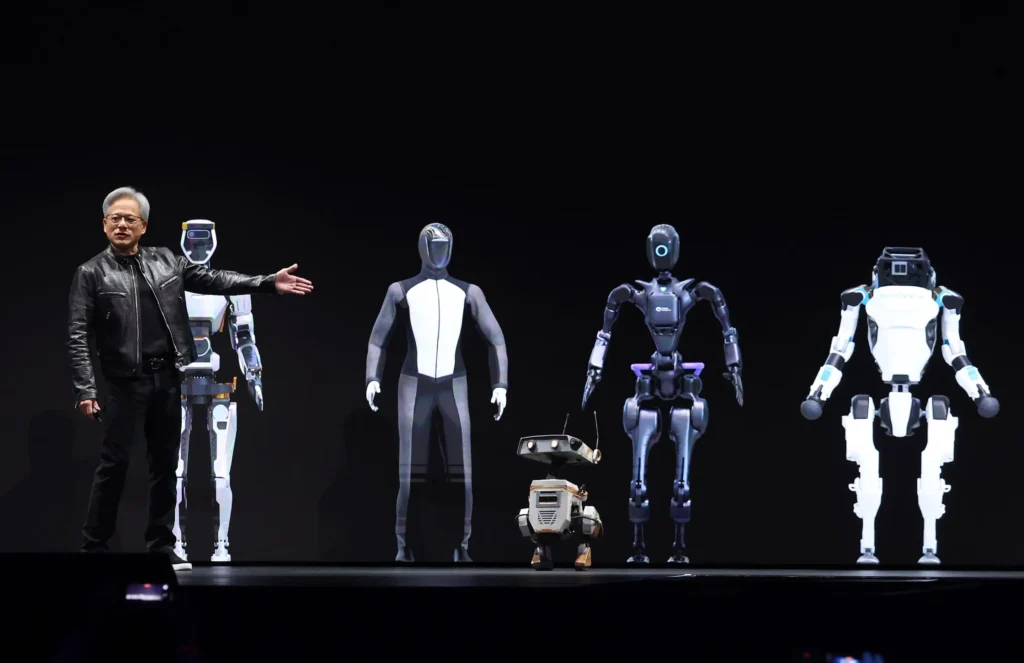Nvidia CEO Jensen Huang, during a speech at a Taiwan tech conference, once again placed a strong emphasis on the future of robots. He predicted that self-driving cars and humanoid robots would enter mass production in the coming years, highlighting Nvidia’s significant role in this robotic revolution. Nvidia, renowned for its software and hardware solutions, is strategically positioned to capitalize on the burgeoning robot market.
Jensen Huang’s passion for robotics is well-known. Earlier this year, he showcased nine human-like robots onstage, underscoring his belief in the potential of these machines. During his Sunday speech, Huang reiterated the importance of two specific types of robots: self-driving cars and humanoid robots. According to him, these would become “very high volume” products due to their broad applicability and transformative potential.
Huang articulated a vision for the next wave of AI, which he termed “physical AI.” This new wave of AI involves systems that not only process data but also understand and interact with the physical world. “AI that understands the laws of physics. AI that can work among us,” he explained. Huang’s signature black jacket became a symbol of his charismatic delivery as he described a future where “everything is going to be robotic.” He envisioned factories entirely run by robots, creating an ecosystem where robots build other robots.
Nvidia stands to gain immensely from the widespread adoption of robots. The company has developed sophisticated software and hardware that are integral to the production, training, and operation of robots. One of Nvidia’s significant advancements is the creation of an operating system specifically designed for self-driving cars. Huang announced that Nvidia, in collaboration with Mercedes, would start producing these self-driving cars next year, marking a substantial step forward in autonomous vehicle technology.
Additionally, Nvidia has created an operating system that enables robots to learn and train in virtual environments. Before robots are deployed in the physical world, their systems can be honed in a “robot gym.” This virtual training ground allows robots to perfect a range of skills, from basic motor functions like grasping objects to more complex tasks such as navigating through warehouses. This approach ensures that robots are well-prepared to handle real-world challenges efficiently.
Huang highlighted the adaptability of humanoid robots, pointing out that our world is designed for human use, making it easier for humanoid robots to integrate seamlessly. “The easiest robot to adapt into the world are humanoid robots because we built the world for us. We also have the most amount of data to train these robots than other types of robots because we have the same physique,” he said. This abundant training data makes humanoid robots particularly promising for various applications.
The CEO expressed his excitement about the current advancements in AI and robotics. In March, he described the process of building models for robots as “one of the most exciting problems to solve in AI today.” Nvidia’s commitment to advancing robotics is further evidenced by its investments in robot startups. For example, the company has pledged $50 million to Figure AI, a startup focused on developing robots for dangerous warehouse jobs. This investment reflects Nvidia’s broader strategy to support innovative solutions in the robotics field.
“This isn’t the future. This is happening now,” Huang emphasized during his speech. His words underscore the rapid pace of development and the immediate impact of these technologies. The financial markets have responded positively to Nvidia’s advancements, with the company’s stock increasing by 180% over the past year. This surge reflects investor confidence in Nvidia’s strategic direction and its potential to lead the robotics revolution.
In conclusion, Jensen Huang’s speech at the Taiwan tech conference painted a vivid picture of a future dominated by robots. From self-driving cars to humanoid robots, Nvidia is at the forefront of this transformative wave. The company’s innovative software and hardware solutions are poised to play a crucial role in shaping a world where robots are integral to daily life and industry. As these technologies continue to develop, Nvidia’s influence and impact on the robotics landscape are set to grow, heralding a new era of physical AI.
